Whose is it anyway?
An Easterhouse living archive production

Easterhouse Living Archive group
Platform and Easterhouse Library, The Bridge


Easterhouse Living Archive group
Platform and Easterhouse Library, The Bridge
The Easterhouse Stained Glass Window was unveiled at The Bridge, Easterhouse, in July 2025. It was created collaboratively by local residents of Glasgow North East with the artist Keira McLean.
A mutual passion for working-class history, archives and sharing stories led to the Easterhouse Living Archive group first being formed. Since then we have spent months talking, writing, researching, drawing, moulding, cutting and shaping to create a lasting tribute to the community, in this the year of our city’s 850th anniversary. The imagery displayed in the window is a collage of archival material, original artwork and personal experience. It brings together fascinating elements from the history of Easterhouse and Glasgow North East to ask the question: “Whose scheme is it anyway?”
The final outcome is a beautifully crafted artwork, handmade with the professional support and guidance of lead artist Keira Mclean and the team at RDW Glass Studios in the East End.
This publication, edited by Joey Simons, is intended as a companion piece to the window, drawing together original writing, illustrations and archival discoveries made by the Easterhouse Living Archive group in the course of the project.
Designed, created and hand made by:
Angela Rooney
Brenda Gilmour
Fiona Doyle
Frank Doyle
Gillian Grant
Ian Montague
Janice Taggart
Kit Ching McKeown
Lynn Freebairn
Margaret Coletta Mass
Peter McMahon
Robert Haughie
Rosemary Whitley
Funded by Glasgow City Heritage Trust
Supported by Platform in partnership with Glasgow Life Libraries.

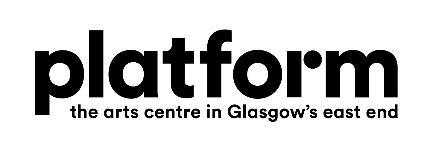

The idiom 'someone's got to do it’ springs to mind. But it's misleading. It implies nobody really wants to. Nothing could be further from the truth. Folk have been celebrating Easterhouse and its communities since it emerged as a small farming village. Prior to that they celebrated Bishops Loch and Provanhall. After all, its unofficial mascot is the phoenix. In a way, there is too much history here. Too much to comprehend anyway. Well, not in one sitting. Which explains why we come back, again and again, year after year, finding new ways to explore and document the stories of this incredible place. Someone’s got to do it! This publication accompanies the unveiling of a new stained-glass window celebrating Easterhouse in all its complicated glory. Throughout the project, long-term residents have commented that growing up in the scheme “it felt like life didn’t happen here, it happened elsewhere. This was just a place to rest your head” or that “people never really ‘came’ from Easterhouse.”
But at the same time, in the struggle to take from life what the working class is owed, and too often denied, people have transformed that truth. In our group are artists, writers, poets and filmmakers; trade unionists, socialists, disability rights, anti-bullying and anti-racist campaigners; nurses, chefs, factory workers and carers. In this year of Glasgow’s 850th anniversary, we have reflected on the celebrations that took place for our city’s 800th anniversary in 1975. A lot has changed and got better since then. A lot has also stayed the same or got worse. History never stands still and nothing is ever decisively won or lost. The future of Easterhouse remains up for grabs. The only thing we can be sure of is that it will be the people themselves who must be in the lead. The history contained in the following pages shows that Easterhouse is a community that refuses to be crushed by the powers that be. Stained glass has a complicated history of its own. Especially here, in this place, this city. Glasgow was once the stained-glass capital of Europe, housing the best studios and artists. It was everywhere: homes, municipal buildings, hospitals, shops, libraries. Much has been lost or destroyed. Its production was often the result of colonial wealth and its subject matter rarely depicted ordinary lives or working-class histories. Fortunately history isn't something that sits fully formed in permanence. You can take the best and worst of it and change its course. What remains is the truth that Stained Glass is the perfect medium for storytelling. A material capable of absorbing and reflecting our shared history and cultural imprints. The Easterhouse stained-glass window will now stand as an ever-changing testament to an everchanging community.
The materials collected in this publication have been written, illustrated, selected, donated discussed and montaged in the course of conversations and workshops that have taken place at Platform, Easterhouse Library, the Mitchell Library and the RDW Glass Studios over the past year and, in truth, for many years before that. The layout has been inspired by The Voice newspaper and Ron Ferguson’s brilliant publication The Writing’s on the Wall: new images of Easterhouse (1975). Hopefully readers can find new and unexpected connections in the refractions of the Easterhouse stained-glass window.
Keira McLean & Joey Simons, Glasgow, July 2025

Apron Strings, a collective poem by
Easterhouse Living Archive group
The glue that holds the fabric of the family
The apron strings pulling the family tight Up at the dawn to make ends meet There’s never time to sleep.
“My great-great granny was a howdie in West Meryston – there were two of them at either end of the village. Her name was Kirsty Robertson née Cowan. Mary Robertson was her niece. She went on to become a qualified midwife.” (Frank Doyle)

Mary Roberston, Memoirs, transcribed by Ian Montague, archive of Frank Doyle
As long as women have given birth, they have needed someone to tend, support, help at the birthing, and care for them and their babies afterwards. There have been midwives in Scotland for centuries, using instinct, ancient learnings, customs, folklore and habits, but ‘unqualified’ as understood today. It was not until the twentieth century that midwives achieved the statutory regulation and with this the new status of being certified…The term ‘howdie’ came into common use in the later centuries of the second millennium. These uncertified midwives learned the craft of midwifery by observing other howdies, or the local general practitioner (GP), at work…
The majority learned midwifery practice by accompanying, and learning from, a woman known for her experience and so gradually developed reputations as midwives themselves. Howdies built up a trusting clientele by word of mouth, by stepping into the shoes of their predecessors, or on the recommendation of a GP…The midwife’s bag was looked upon as a passport, for instance to the top of the queue for the Glasgow trams. Margaret Dearnley, who was a midwife in Glasgow in the 1940s, recalled:
“You wore your uniform, you’re carrying your bag, and if you went to stand in the tramcar line, they would say ‘Oh – great big queues of people of course – ‘Here’s the nurse, some puir sowel’s waitin on her comin.’ And you were pushed up the line and they let you on. And the driver would say, ‘Where are you going nurse?’…They would stop at the close that you wanted to go to. Wasn’t that fantastic?’
From Lindsay Reid, Midwifery in Scotland (Scottish History Press, 2011)
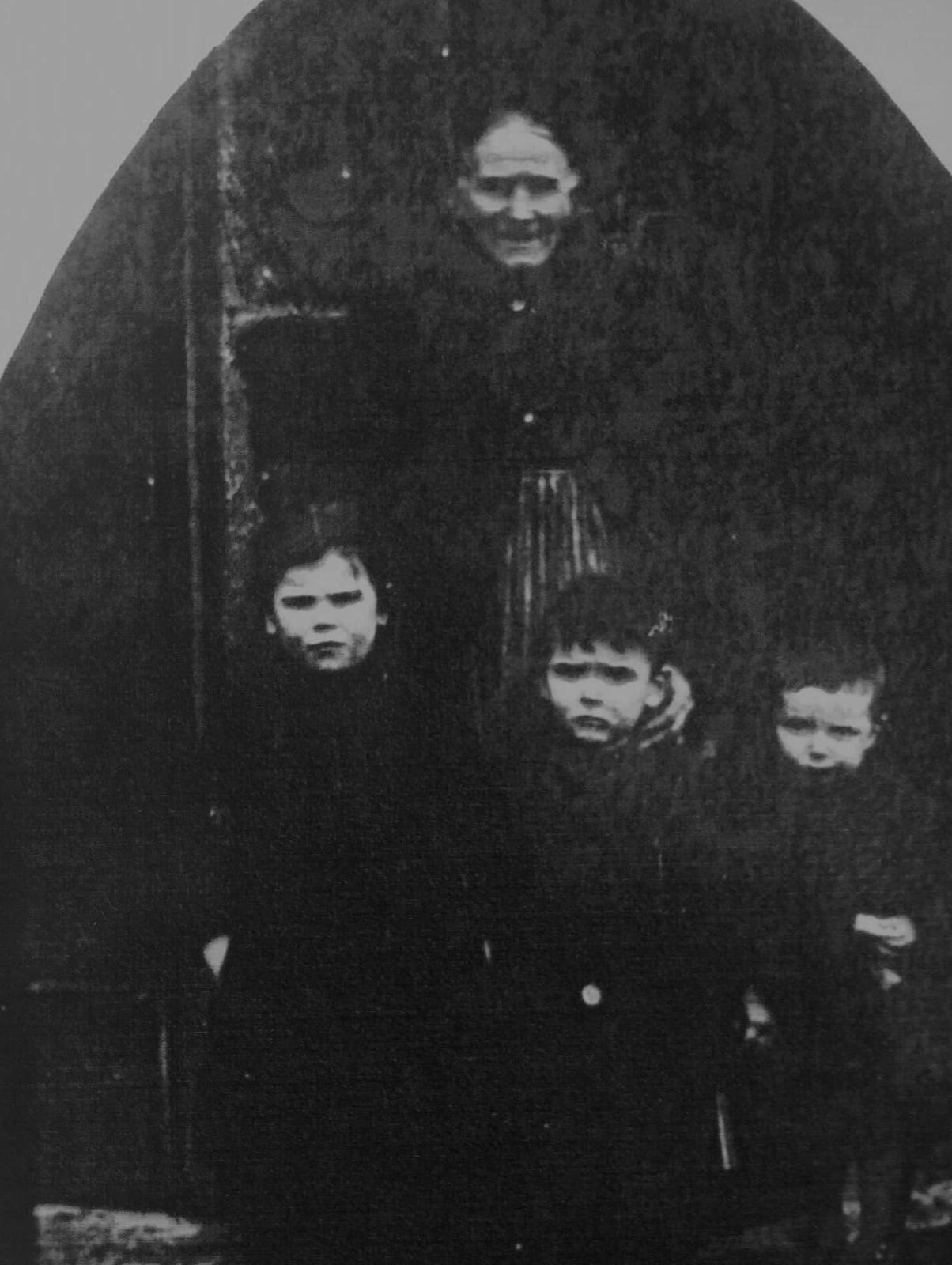
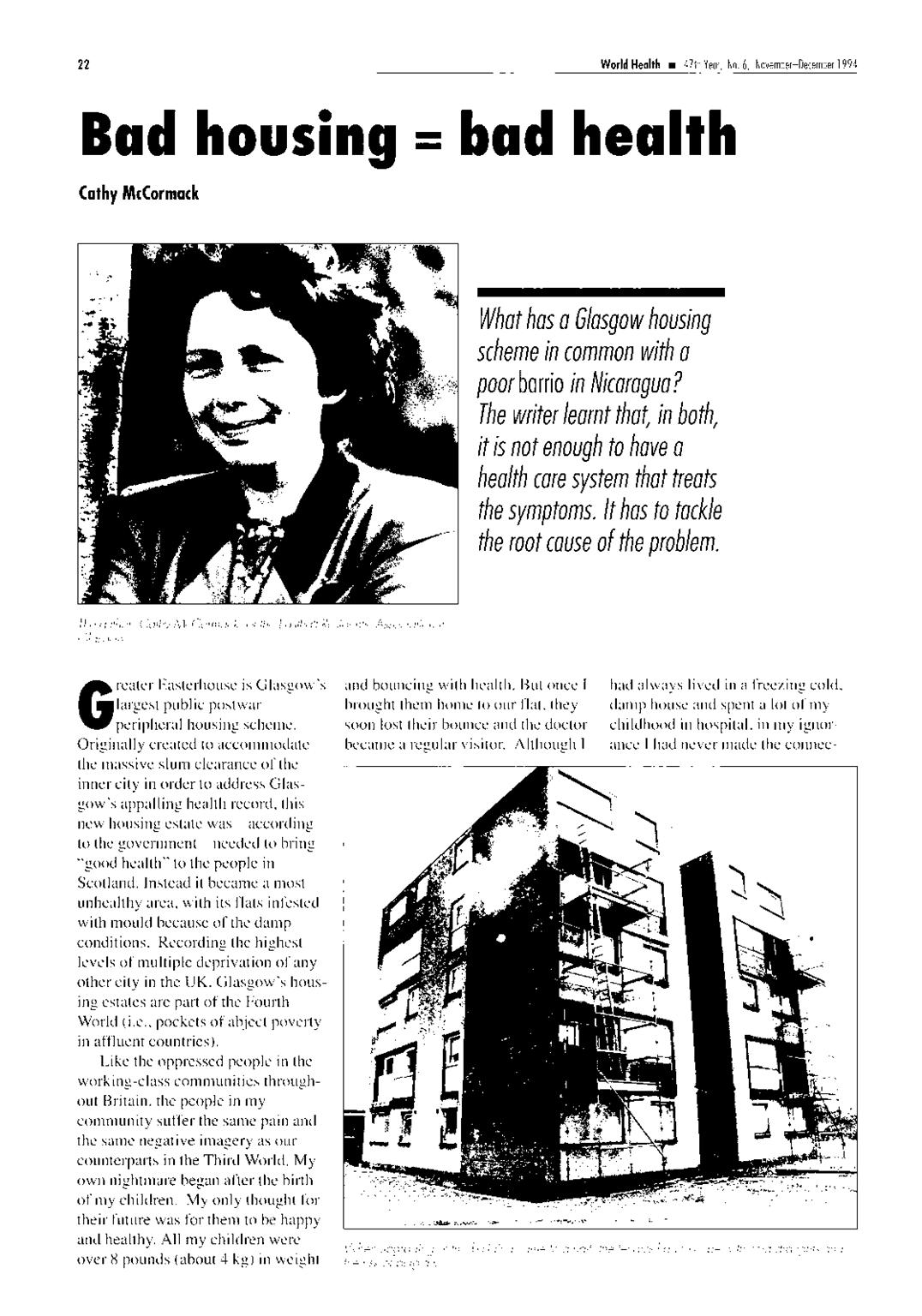
Margaret Coletta
I was born in the 1950s, which was a time of poverty, and there wasn’t a lot of community activity, although there were lots of happy times with family. Grandparents often stayed with the sons and daughters. My family were seven siblings and my parents, but we still had room for my Italian Grandad when he couldn’t live on his own, after my gran passed. There was love and connection.
Before my Mum, Dad, two older brothers, two older sisters, my younger sister and I moved to Easterhouse we lived in Duke St in Glasgow in a one bedroom bedsit. It was a bit of a squeeze but was quite common for working class people in the city. We didn’t have a lot of money or material things and times in the fifies and sixties were really hard. My mum and dad always provided for us as much as they could, and my dad worked all the hours he could while my mum looked after all of us…
After a few years, when I was about four, my mum & dad then got word of moving to a new house in Easterhouse. At that time ‘the scheme’ was just getting built, but later came to be known as one of the biggest housing estates in Glasgow and also in the UK. It also became well known for other reasons like poverty, gangs and other social problems, but I was a toddler and untouched by this. The little light of happiness and hope burned steadily within me in the safe environment of a loving family home. Easterhouse was mostly tenement buildings, six families in each block. We had three bedrooms, a kitchen a bathroom and a living room. There were a lot fields where our new house was…
My mum and dad thought this new house was amazing! We all did because we didn’t have as many rooms before, and we didn’t even have a separate kitchen or an inside bathroom in our in Duke St. This was luxury! An inside toilet and a ceramic bath not like the tin one we had before. This was posh for us! The Ritz! When we moved to Easterhouse it was so nice to have all this space. As I said, yes there were gangs that used to fight over at the pitches; they had weird names like ‘The Drummie’ and ‘Then Den Toy’ but we would never see anything. We were safe and protected. I would just hear my brothers and sisters talking about it the next day, or if my mum was speaking to one of the other neighbours about it. Easterhouse got a bad name because of this, but no matter where gangs were fighting or where you stayed it was always Easterhouse that got the bad name. The new scheme with big hopes and vision for the future wasn’t turning out the way people had dreamed. Though we had much more space, I still had to share a room with my three sisters’ my two brothers shared a room and my mum and dad had ‘the big room’ of the house.
My mum and dad were amazing people to me, my role models, my protectors, my providers and sometimes even my friends. They were kind, thoughtful and caring…
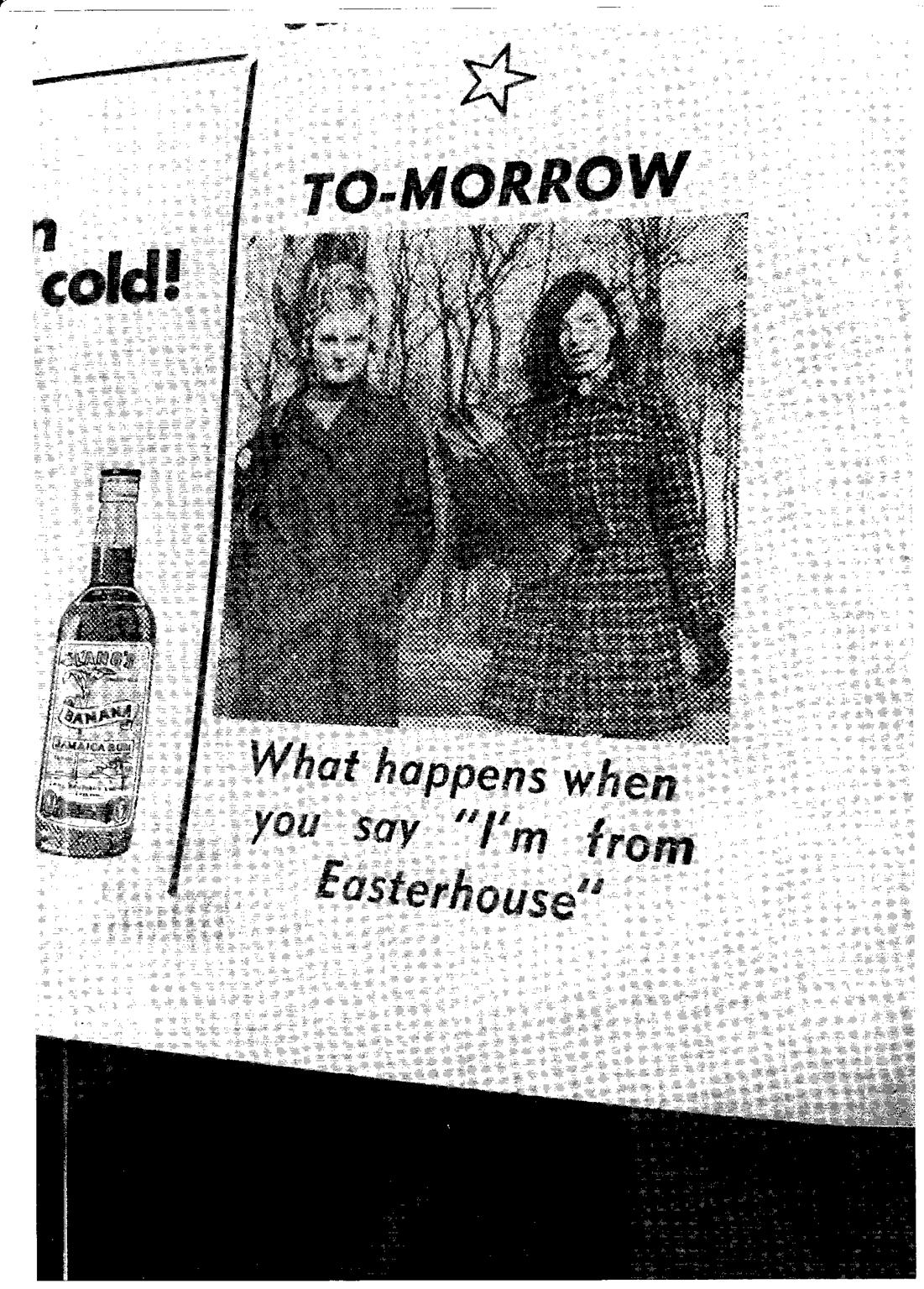
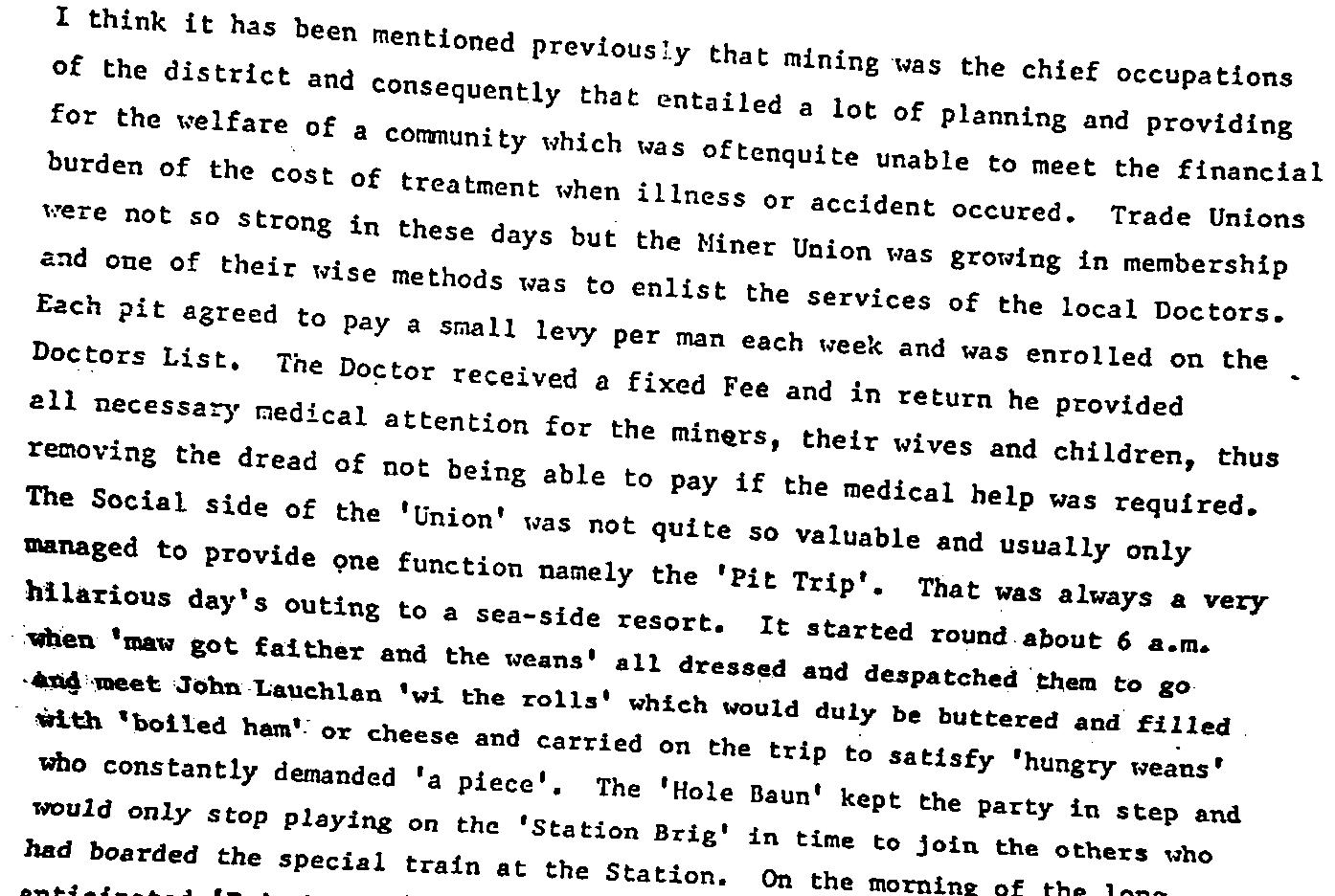
Mary Roberston, Memoirs, transcribed by Ian Montague, archive of Frank Doyle
The Sunnyside Club
Davie & Jean Wallace started the Sunnyside Club. The Club met at the Sunnyside huts on Tuesday nights. We went on bus outing to Saltcoats, Blair Drummond Safari and Adventure Park, the Sea Life Centre in Loch Lomond, and we went on great holidays to Millport for a weekend – which were great weekends. The Sunnyside Club ran for 11 years.
Peter McMahon, History of Sunnyside Club for Children with Additional Support Needs
The BRACE Club
I was in the B.R.A.C.E club for 30 years since it was started. It was a great social club. You paid £3.00. The club met on Monday nights at Ashcraig School for pupils with additional support needs and Wednesday nights at Ruchazie Huts on Ruchazie Road. The BRACE had a very good committee who ran the club each week. The club did a lot of fundraising for the benefit of the members. There were some great Easter, Halloween and Christmas parties and there were bus outings to Ayr, Burntisland and Saltcoats and other nice places and even great club holidays to Spain and America. The places were all great and you always got nice food. The BRACE Club got its name from were all the members stayed.
Peter McMahon, History of the B.R.A.C.E CLUB
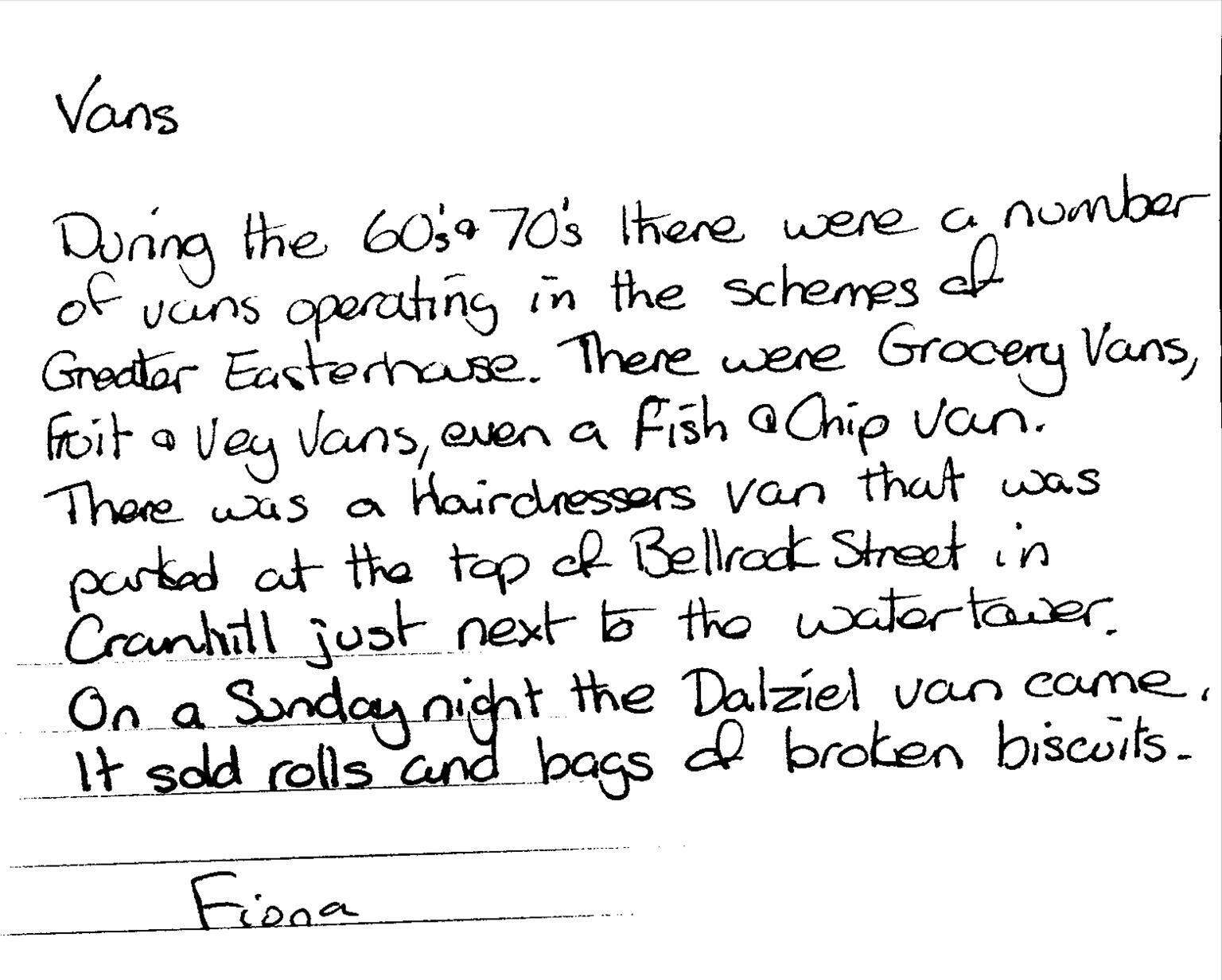


Freedom to roam by Easterhouse Living Archive group
We had freedom to roam
But time just slipped away
The only thing we had to do
Was be home by the end of the day
The bogfields were a danger
But that was where we played
To travel doon to a different world
A raft is what we made
The coal, the peat, the tatties
The green and open fields
Belonged to us who wandered there
To feed our dreams and needs
Between the dods of concrete Woods sprouted from the soil
Before the concrete buried all Rooted in our toil
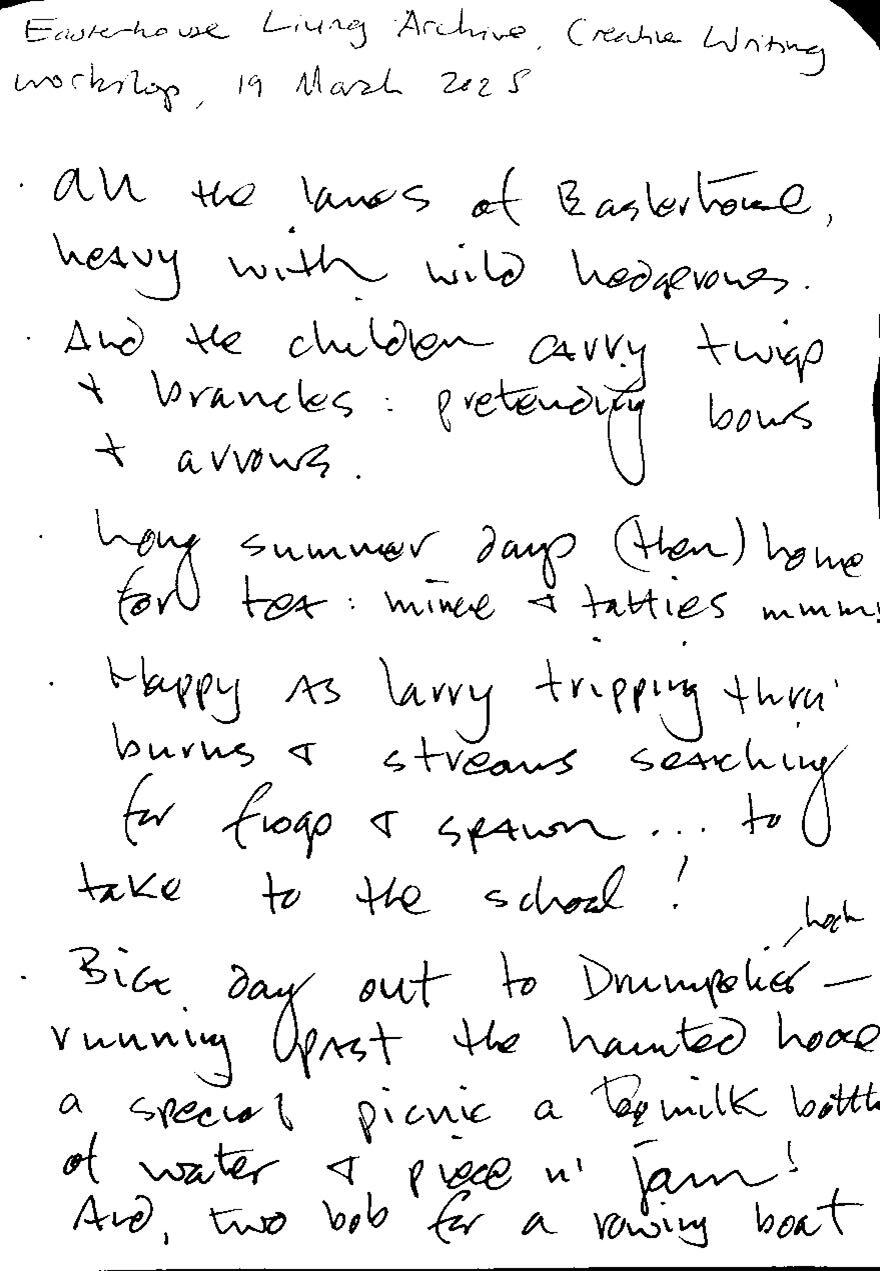
A Wonderful Playground called “Nae Place”
Mary Robertson
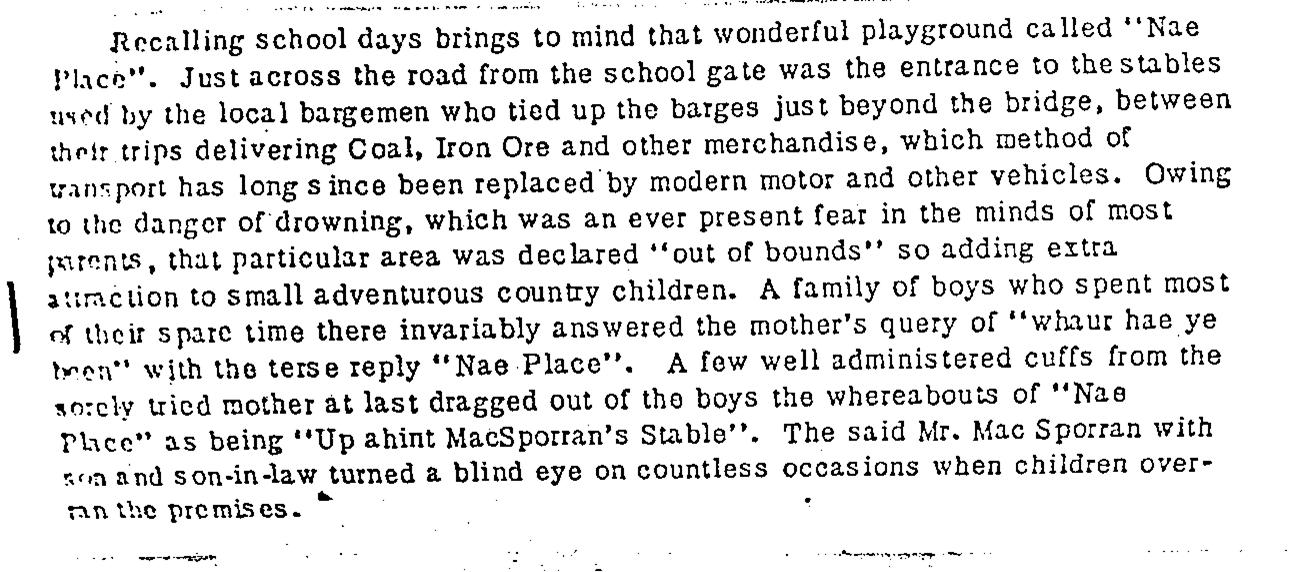
“I went up the Sugarolly mountains, by the Cranhill flats near the canal. I did it a couple of times, climbing up and sliding down, even though I was fearty. I came home completely back and got a row. What’s the origins of the name? Maybe from black liquorice sticks? What were they made of? I’m not even sure.”
Conversation with Brenda
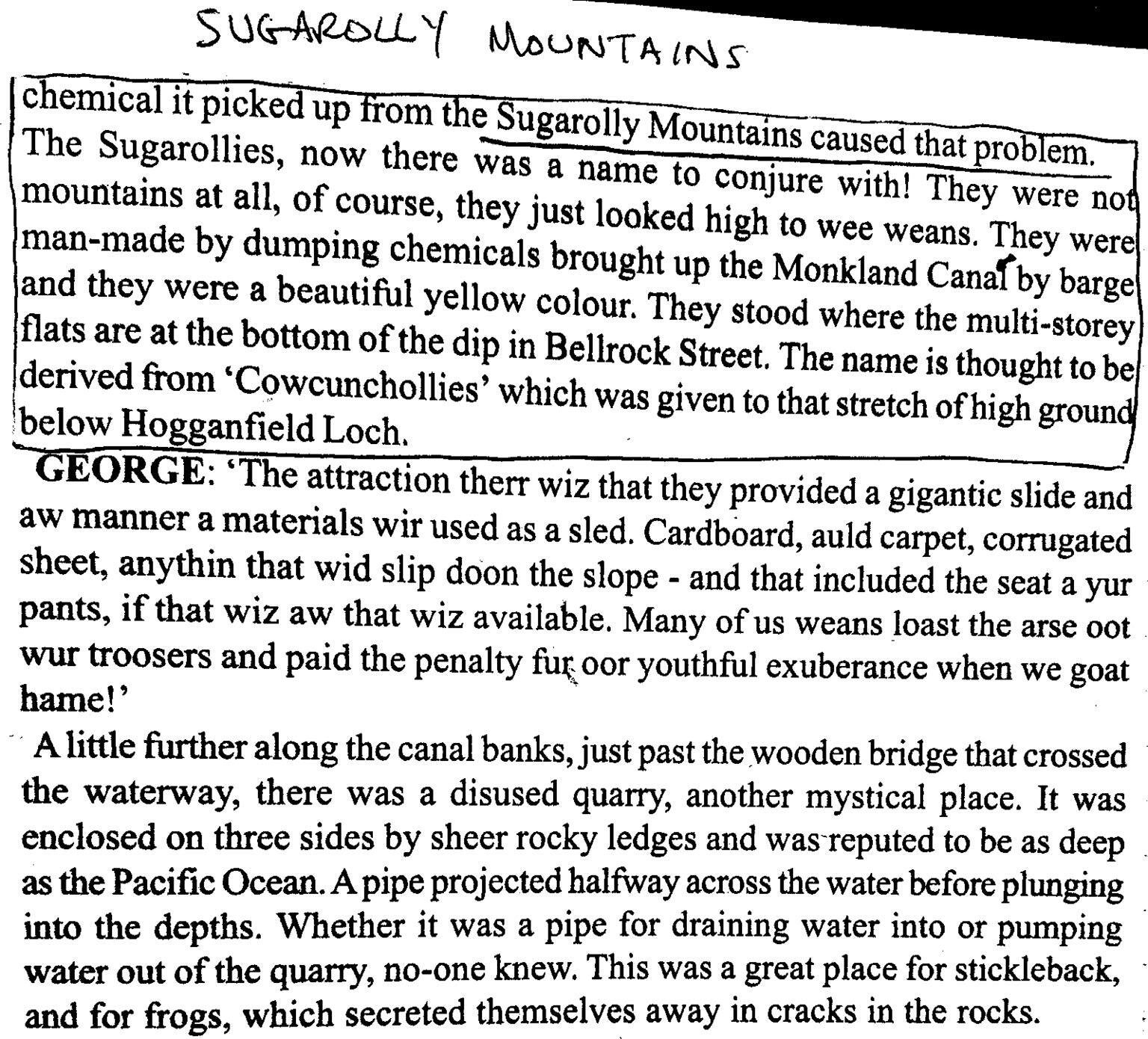
Glasgow Heritage Group, Glasgow Memories: The East End

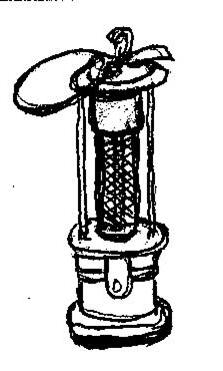

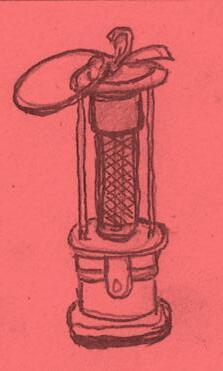

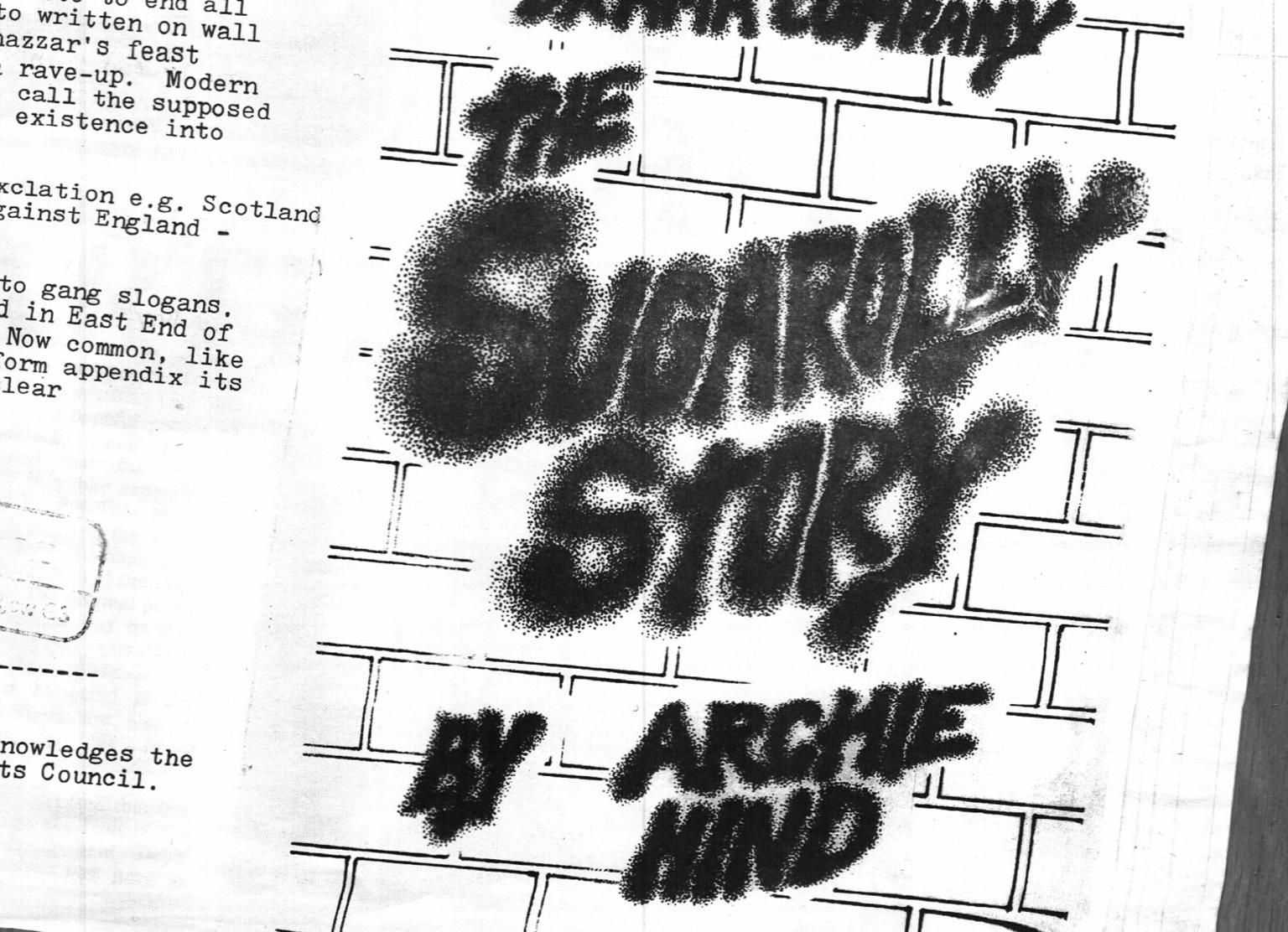
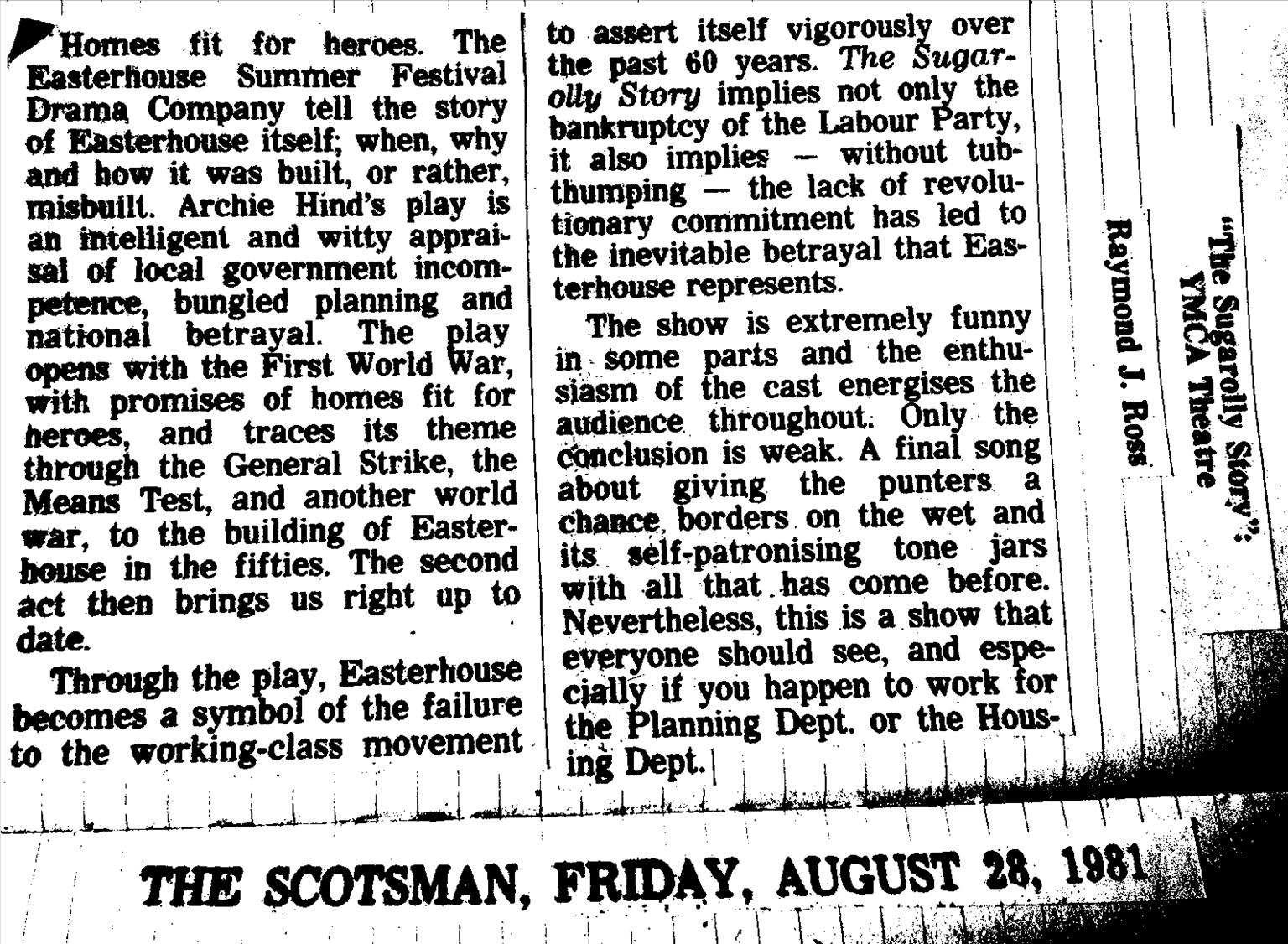
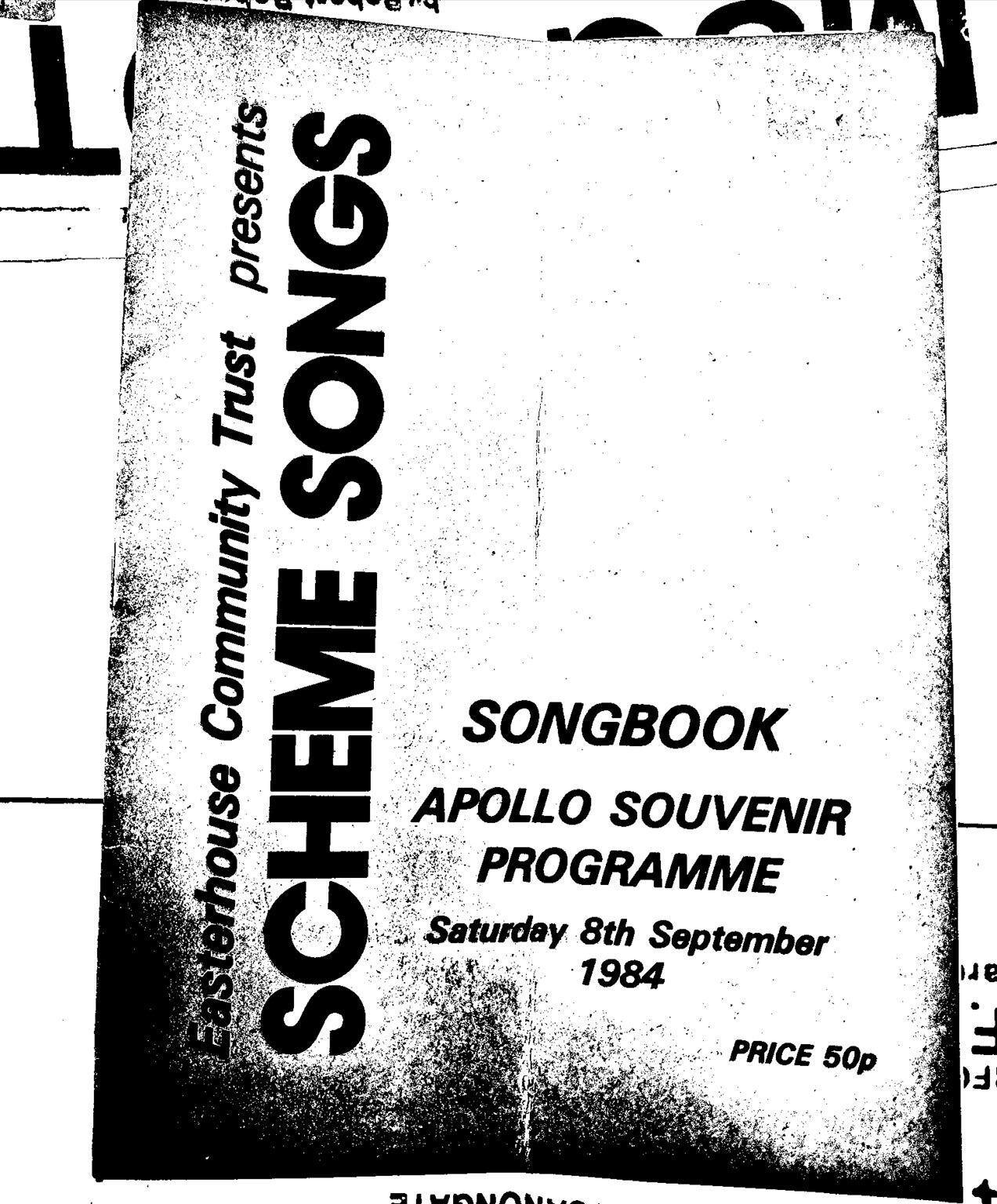
Nae nothing – notes towards a song
Easterhouse Living Archive Group, 2025
We had freedom to roam but time just slipped away
The only thing we had to do was be home for the end of the day
The pits have all been filled in The industry is gone
But as long as we stick together
Together we’ll be strong
Nae buses
Nae schools
Nae post offices
Nae pubs
Nae nothing at all
But as long as we stick together
Together we’ll be strong
As long as we stick together
Oor community never fails

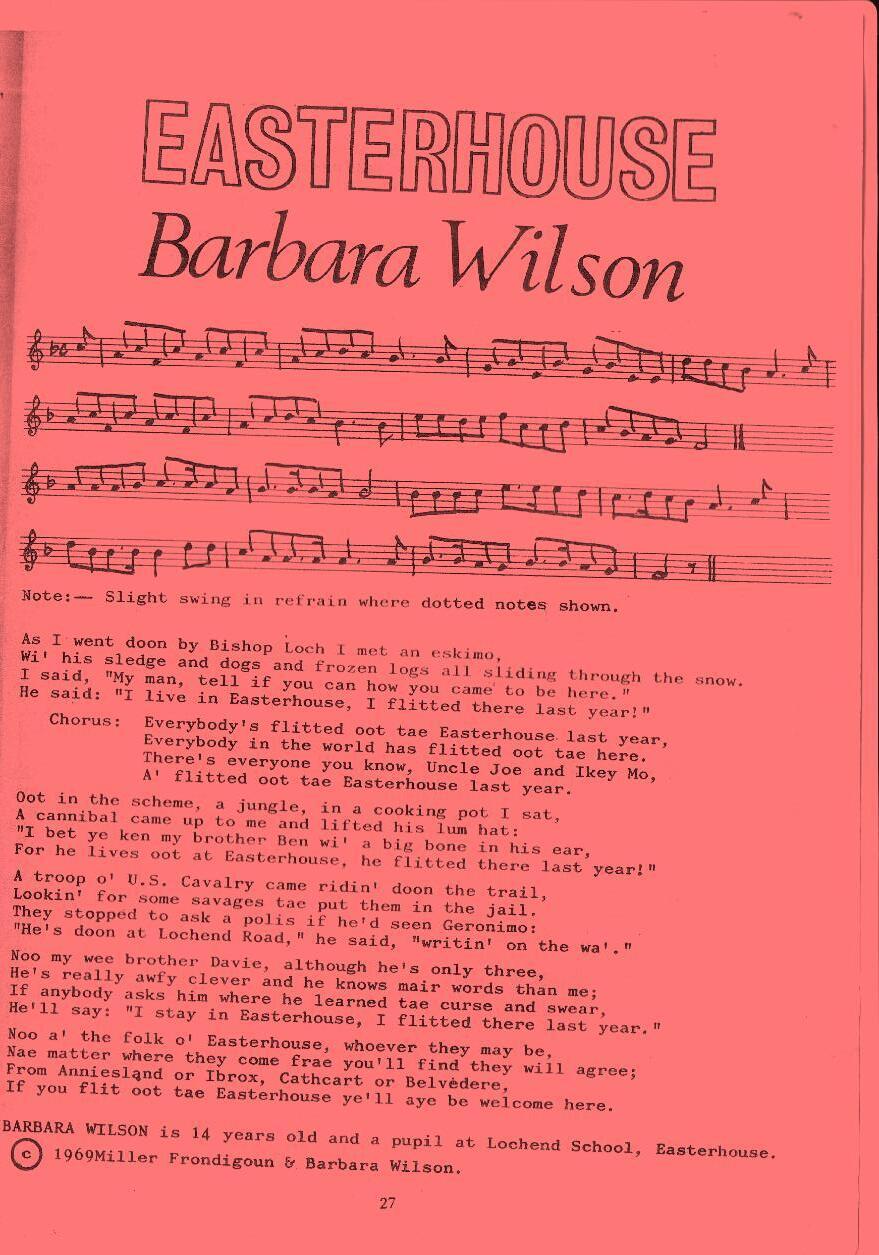
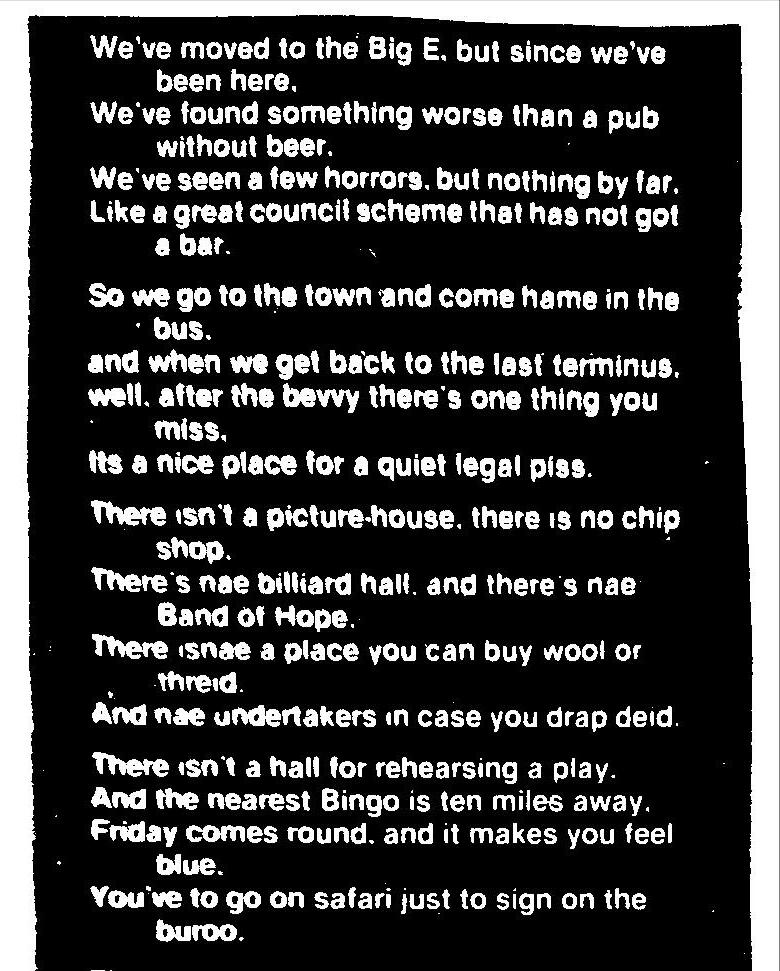
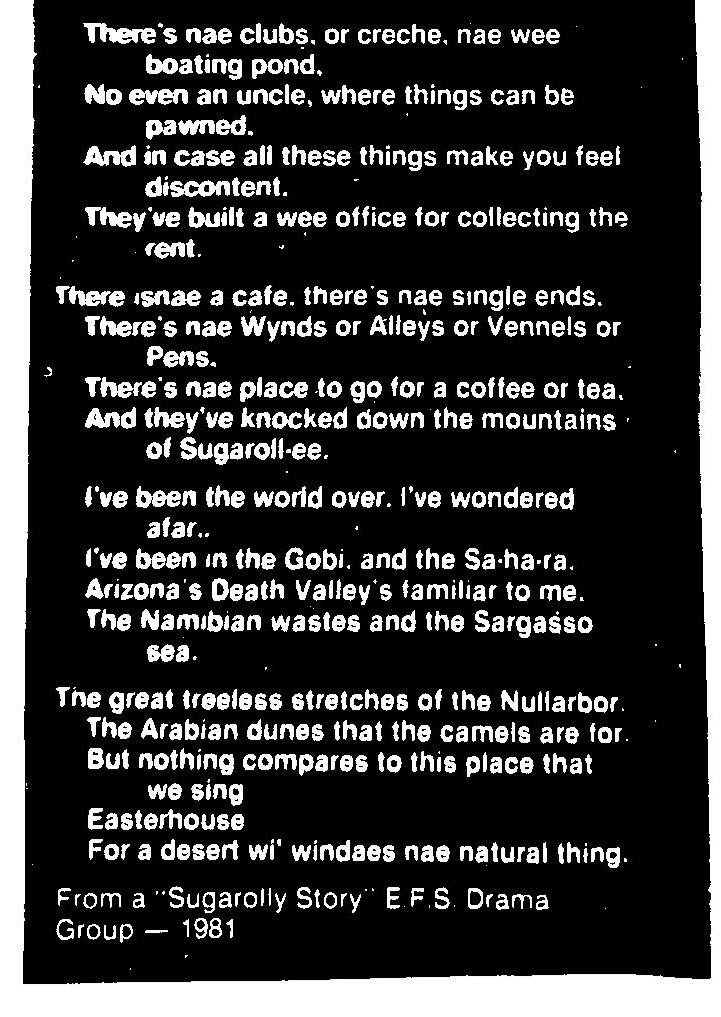

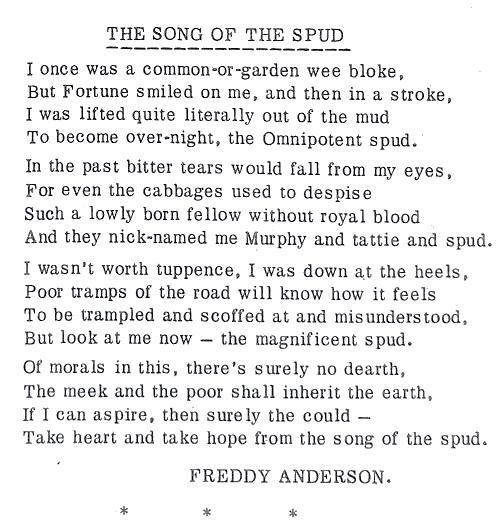
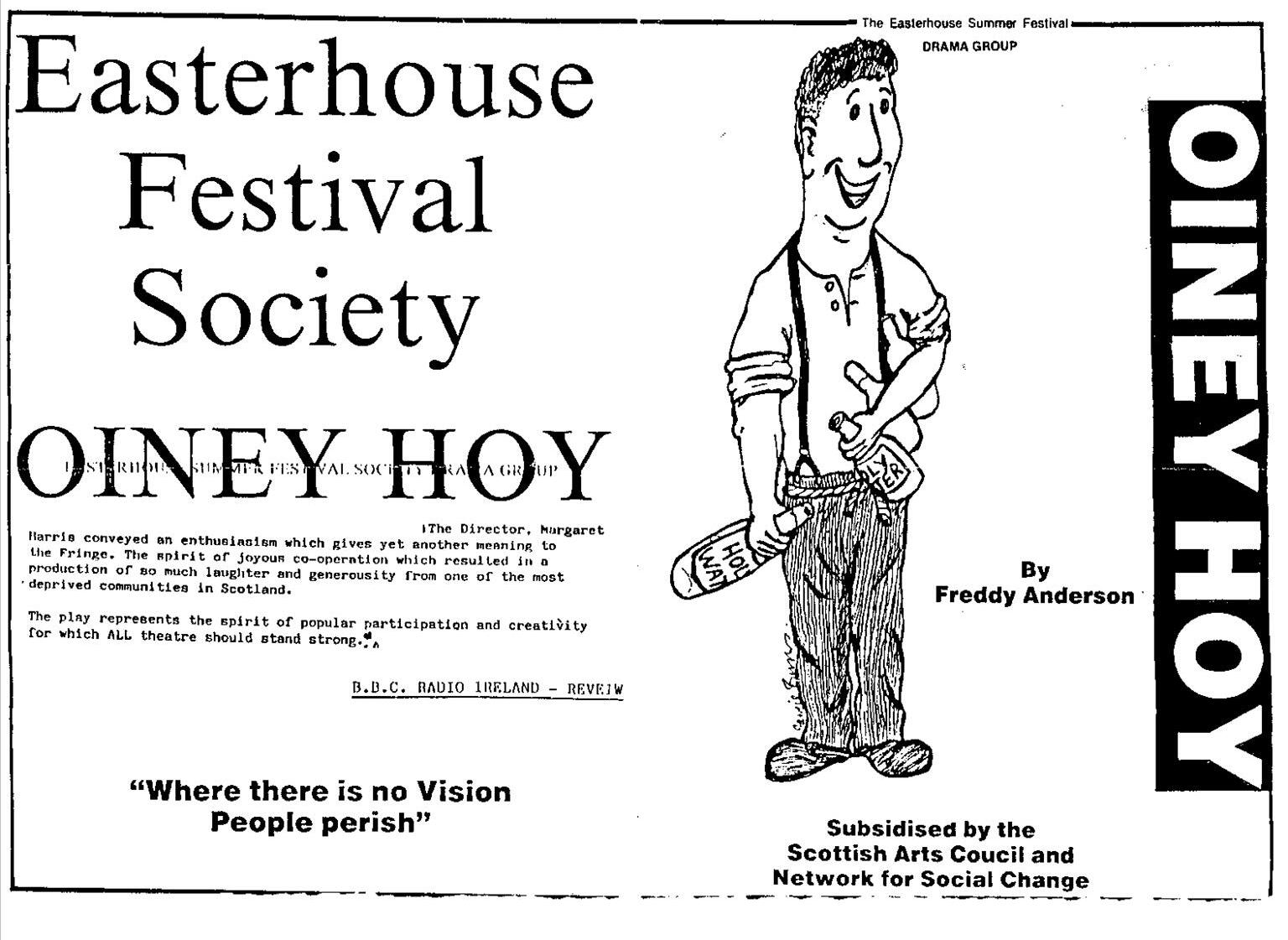

Peter McMahon
We’re proud to be the trunk, where all the branches have started from. We are very pleased to see how the branches have spread over the area.
The Easter Club began started in April 1969 – hence the name Easter Club (Easterhouse, Eastertime). The founder of the club was a Mrs. Reilly. She felt there was a need in our area for children with additional supports need to go, as many of our members were at that time unacceptable in schools. Many parents came along to our Friday meetings. They passed on knowledge to each other as there was very little information available to us at the time. The parents of Easter Club campaigned for children with additional support – Enable. Eventually the right to be educated in special educational support needs schools was thankfully passed in an Act by the Westminster government.
When new places like Cumbernauld, East Kilbride and Livingstone opened, many of our people moved to better houses for their sons or daughters. Out of our original people that were in the club from the very beginning only four remain, faithfully
keeping the club going each week. The people in Easterhouse have always been good to us in our fundraising efforts, and we have a few volunteers who help us out each week and we are very grateful to them.
Our first holiday was to Ayr for indoor camping in a school. Everyone still enjoys talking about that holiday. We still go on our annual bus outing, taking along some old friends from Eskdale home for the elderly. Each year at Christmas we are invited to Eskdale for a Christmas party and disco.
Nearly all our weans have grown up now but fundraising still goes on, with all the usual things done to make money.
The Easter Club has always been very independent and is not associated to any other club. We are proud to be the trunk, where all the branches have started from. We are very pleased to see how the branches have spread over the area.
We were the first group to be accepted out with children’s home for the Annual Glasgow Taxi Outing to Troon. Many of our members still go each year on this outing.
We hope the Easter Club will run for many years to come and continue to be a place our people can call their own.
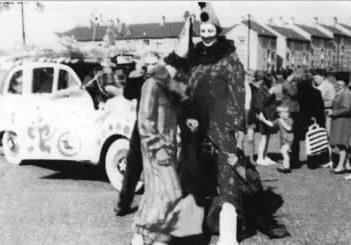
Rosemary Whitley
Primary school was over, it was the summer of ‘76 we'd walk Baillieston to Easterhouse, looking for some kicks. A cone fae a van, cream soda for a treat, fair cooled ye doon in blistering heat. Moseying aroond the shopping centre, plastic sandals oan sair sweaty feet.
Ah started 1st year high school, at St Ambrose in Coatbridge but the school went oan fire, so us weans hud tae shift. Ah wis gutted aboot huvin’ tae be taught elsewhere cause ma school canteen perks wid be nae mare.
Ye see, ma auntie Veronica, heid cook at the time made sure ah didnae need queue in the dinner line. Taking lunch tae the heidy in his office each day Bob Crampsie’s eye aglow, nosh piled up oan his tray.
So, ah wis off tae St Leonard’s, at least for a while and ma trips back tae Easterhouse resumed, in style? It wisnae a carefree saunter tae school wi ma pal it was 20-mile round bus trip, and a ban fae the mal!
We’d board the school bus in Baillieston at hauf past eight pile oan tae another wan outside St Ambrose school gate. Then we’d travel back the same wye we came jist tae get tae St Leonards, a stone’s throw fae hame!
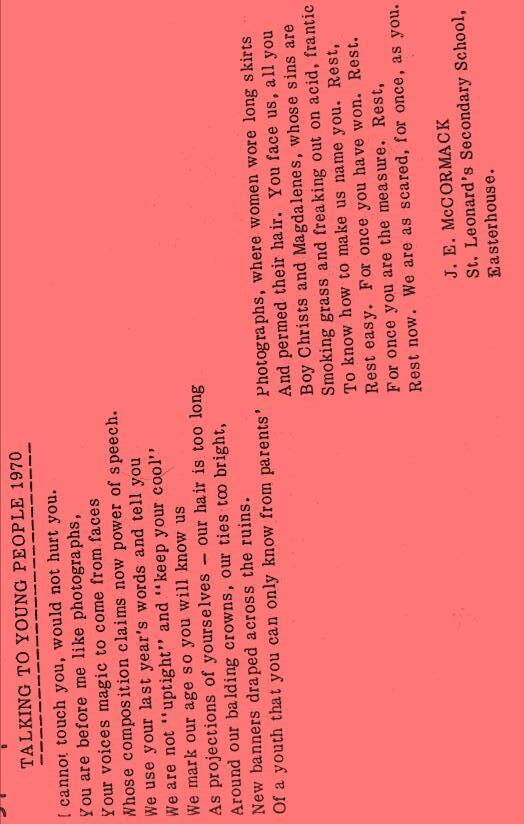
The school bell ran oot at 9 o’clock, but we were telt tae stay oan the bus teachers taking the register and faffin’ aboot, felt like wan big, enormous fuss! Us travel sick weans, well, we’d hud enough, drew daggers and jibed at peers, nae shame! When questioned aboot the rumpus we caused, the St Leonards kids, they wur tae blame!
Seemed there wis nae hope of schools integrating, segregation wid be the lesson of choice separate classes and play times, lunchtimes anaw, we were kids without a voice Shrieks of laughter echoed through walls, fae nameless peers we never knew at all. Walk wi yer heid doon through corridors in haste, hands in pockets, feeling very small. But weans are curious, so rules were broken, and mony a fight broke oot and the kids fae Lochend school across the road, wurnae sure whose tae be oan!
Hazy is my memory of class lessons taught, atmosphere heavy and fraught. The clock on the wall dictated our day, pack up quickly, that wis the way. Hopeful pleas at the end of a day, “kin ah no jist walk hame, it’s no faur away!” That didnae warrant a travel reprieve, two buses and like it, nae matter where you stay.
We boarded the bus one last time, no waves of farewell, no new friends to be seen. Thinking now of my time at ‘the Lenny’, a wry smile, and what could have been. A memory of almost fifty years ago, a brief encounter with a school, sadly, no longer there. Small or tall, all have a voice. A bridge, a platform, and a community to share.
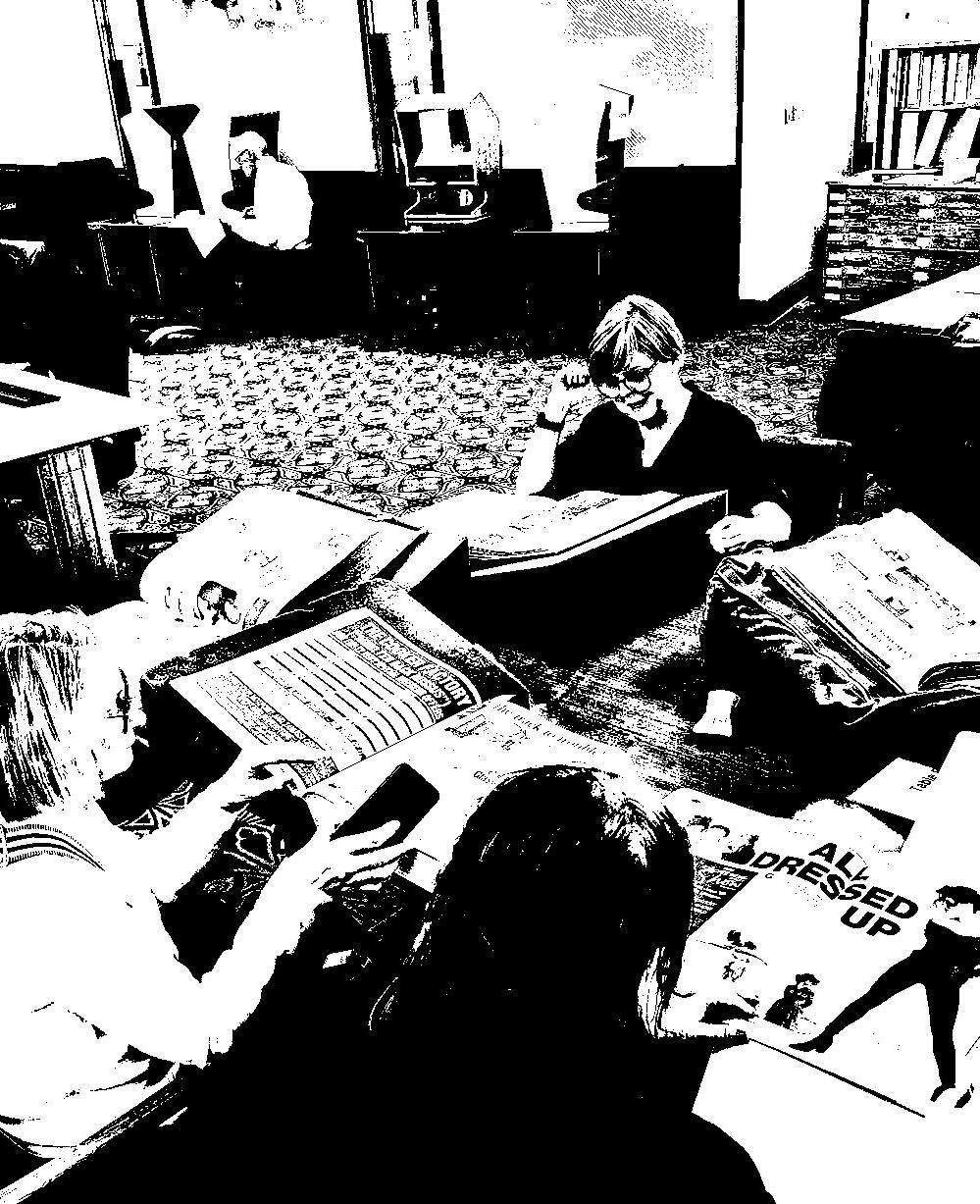
Garthamlock Community Project stage protest ahead of court summons
Holly Lennon, Glasgow Times, 07.07.16
The Garthamlock Community Project have staged a protest outside of Glasgow Sheriff Court. The group were served a with a court summons after refusing to vacate from their current base to make room for a housing development last month.
Founded almost a decade ago, the project acts as a youth group, food bank and dropin centre for locals.
Landlords City Property, an arms-length firm of Glasgow City Council, told the group they had to vacate by April 27 to make way for Persimmon Homes.
Persimmon Homes intend to transform the street into a housing development in hope that it would regenerate the area.
Speaking outside of the Sheriff Court, organiser Geraldine Marshall said: “They’re supposed to be about regeneration but they’ve not put anything back into the community. They’ve spent millions of pounds and Garthamlock has got nothing out of it.”
“Regeneration is putting back into the community, all they’ve done is taken things out. They’re taking all the green space, you can’t see anything now. There’s not a school or a nursery – there’s nothing but houses.”
Doug Law, managing director at Persimmon Homes West Scotland said: “Glasgow City Properties have been dealing with the remaining tenants of the Barholm Square Shops.”
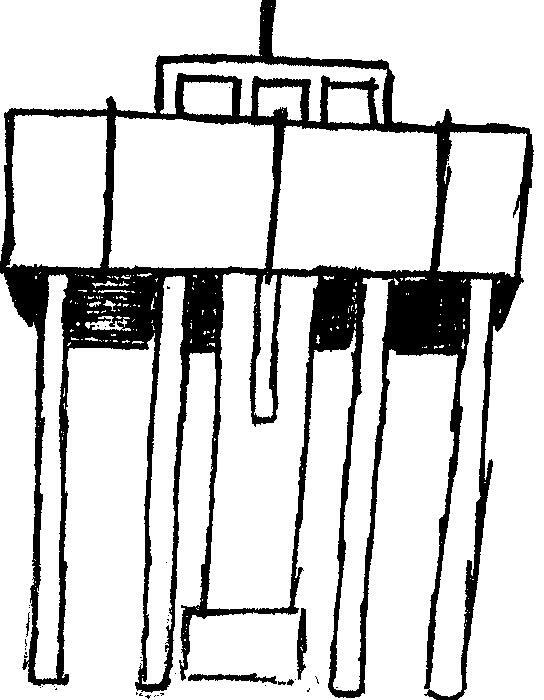

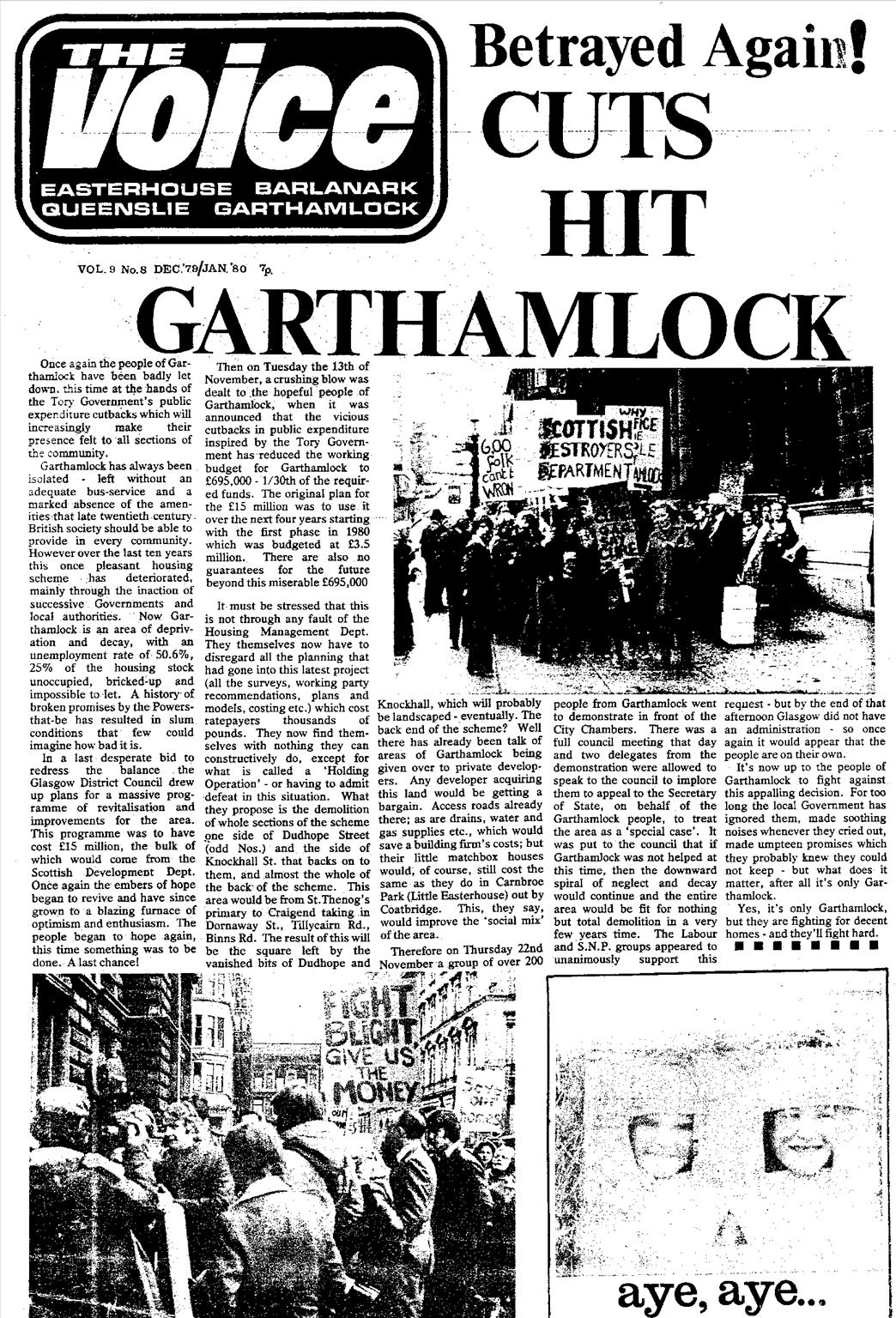
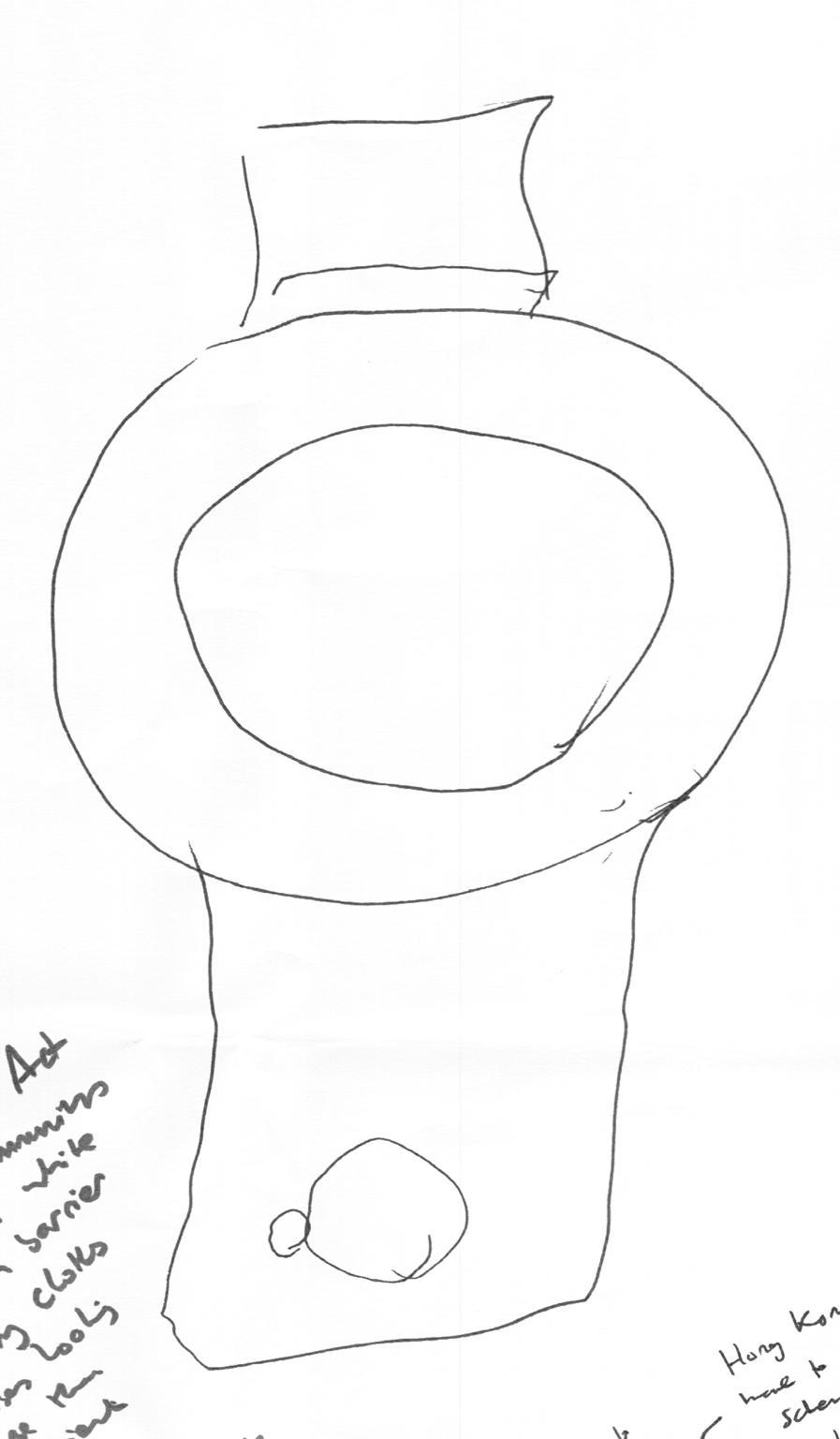
“There was a public consultation going on in the shopping centre and I walked by. They were asking what can we do if we get funding. I said they should put public toilets in, especially for children and older people. They eventually did it but they put in push buttons for the flush and they’re so stiff. We should have chains or handles! No one thinks about these things. Like dropped curbs on pavements for example. For wheelchair users it’s very hard. People don’t want to talk about these things but it’s everyday life. We need to.”
Conversation with Kit
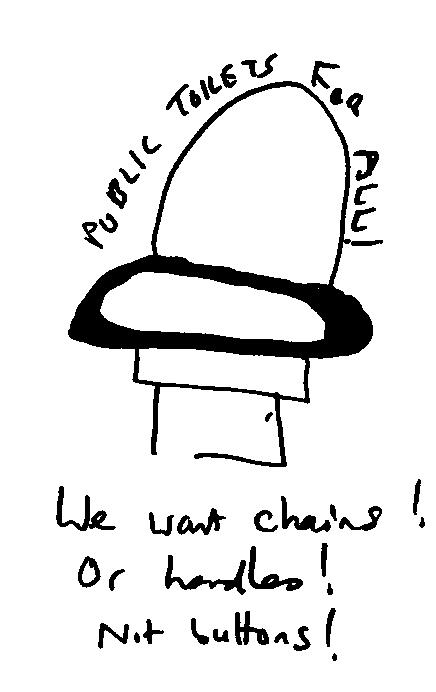
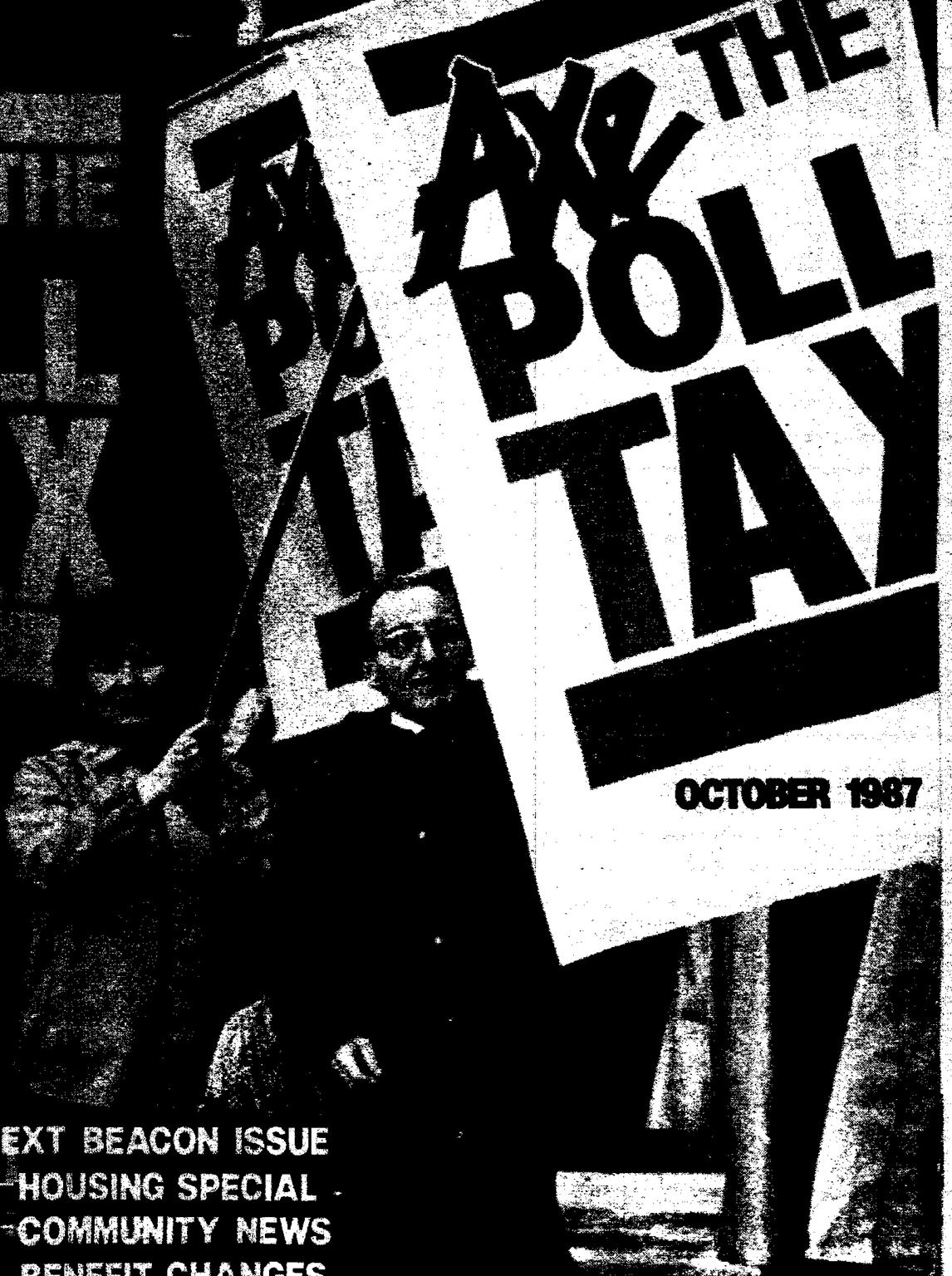
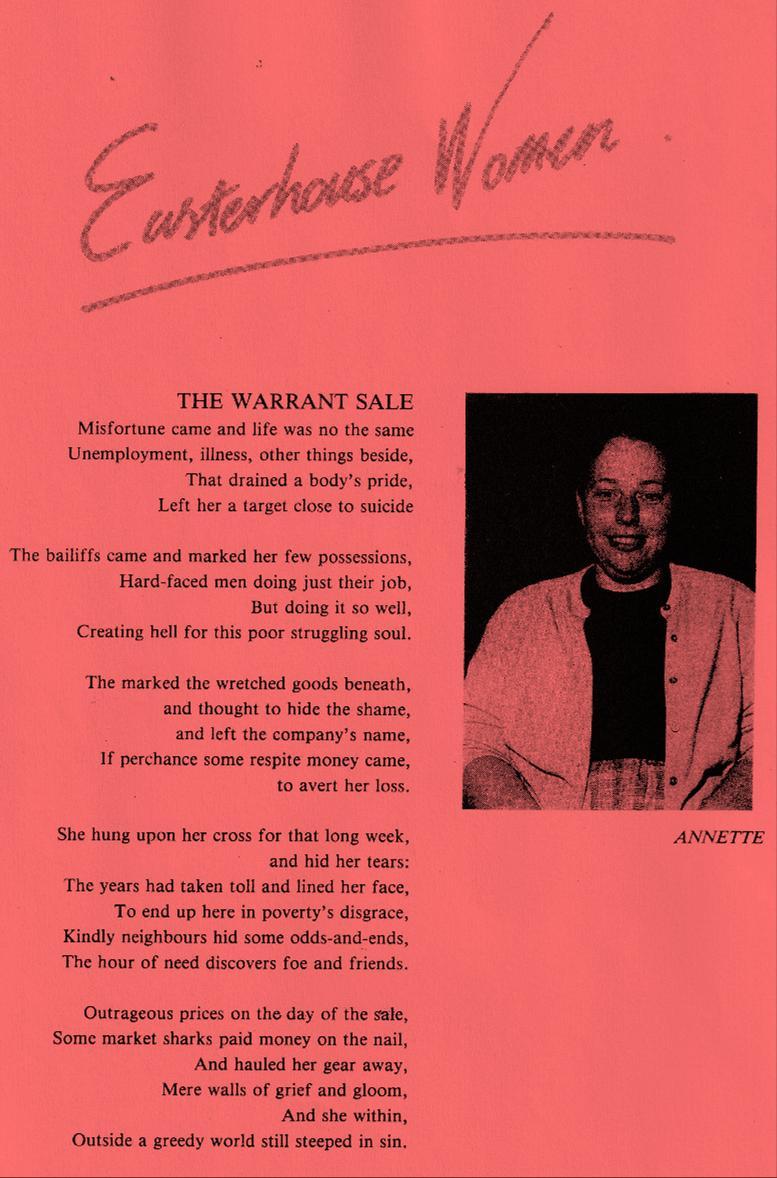
Whoseschemeisitanyway?AnEasterhouseLivingArchive. Edited and collated by Joey Simons (Glasgow: Platform, 2025)
Archival images and materials in the publication were selected from TheVoice, TheBeacon, Chapbook, The Easterhouse Festival Society report - FiveYearsOn(1982), TheWriting’sontheWall:newimagesof Easterhouse (1977) edited and published by Rev. Ron Ferguson, and people’s personal archives and collections.
We would like to give special thanks to Clare Thompson, Special Collections Librarian at The Mitchell Library, Glasgow, for looking out so many of these materials for a brilliant workshop with the Easterhouse Living Archive group.
Also special thanks to the staff at Easterhouse Library who have done a fantastic job of curating the library’s local history section.
A big thank you to Margaret McCormick and all the team at Platform.
The title of this publication is inspired by the documentary Whosetownisitanyway?Easterhousepeople andpower(1984) directed by Tony Freeth.
Dedicated to the memory of Cathy McCormack (1952-2022).
If you would like to get in touch regarding an image credit, please contact Platform by emailing: info@platform-online.co.uk
Platform 1000 Westerhouse Road, Glasgow G34 9JW www.platform-online.co.uk
Printed by MIXAM.
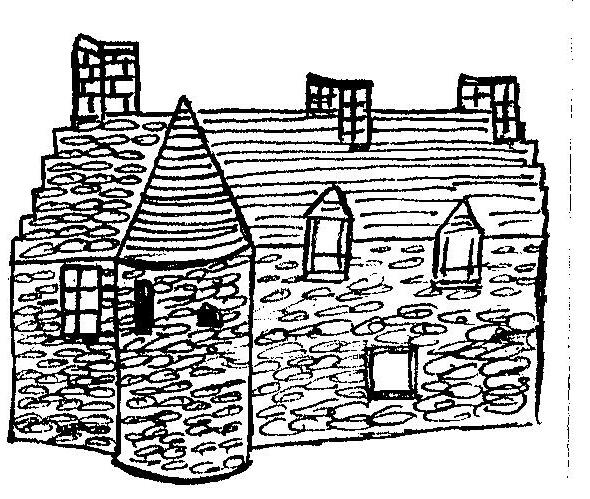

(EASTERHOUSE,